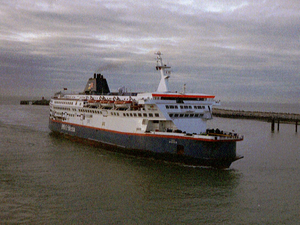MS Pride of Dover
 MS P&OSL Dover in 2002 | |
| Career | |
|---|---|
| Name: |
1987-1999: Pride of Dover 1999-2002: P&OSL Dover 2002-2003: PO Dover 2003-present: Pride of Dover |
| Owner: |
1987:Stanhope Steamship Co. Ltd (Townsend Car Ferries Ltd) 1987:-2006: P&O European Ferries (Dover) Ltd 2006-present: P&O Ferries Ltd |
| Operator: | P&O Ferries |
| Port of registry: |
Dover, |
| Route: | Dover-Calais |
| Builder: | Schichau Unterweser AG, West Germany |
| Yard number: | 93 |
| Launched: | 20 September 1986 |
| Completed: | 27 May 1987 |
| Maiden voyage: | 2 June 1987 |
| Identification: | IMO number: 8517736 |
| Status: | in service |
| General characteristics | |
| Tonnage: | 26,433 tonnes |
| Length: | 169.6 m (556.4 ft) |
| Beam: | 28.27 m (92.7 ft) |
| Draft: | 6.12 m (20.1 ft) |
| Installed power: | 3 x Sulzer ZA40S Diesels |
| Propulsion: | Triple controllable pitch propellers |
| Speed: | 22 kn (41 km/h) |
| Capacity: |
2,290 passengers 650 vehicles |
The MS Pride of Dover is a cross-channel ferry built in 1987 for Townsend Thoresen.
Pride of Dover was the last new ship to appear in service with the famous Townsend Thoresen orange hull though she was delivered with the P&O house flag painted on her funnel which was changed from the 'TT' logo during construction. Townsend Thoresen was renamed P&O European Ferries late in 1987, following the Herald of Free Enterprise disaster, and Pride of Dover was swiftly repainted in the new company colours.
The industry generally regards Pride Of Dover and her sister MS MS Pride Of Calais as the most successful ferries ever built for English Channel service. The ships boast superb handling characteristics and excellent sea-keeping abilities. Between 1998 and 2002 she was under the control of P&O Stena Line and carried the name MS P&OSL Dover from 1999 until 2002. Once returned to P&O control she was renamed MS PO Dover before she was repainted into new P&O Ferries livery when her name returned to MS Pride of Dover.[1]
Pride of Dover primarily operates the Dover–Calais route but on a number of occasions has made crossings between Dover and Zeebrugge as a result of industrial action in France.
Pride of Dover will leave service in either 2010 or 2011 to be replaced by one of two new ferries ordered by P&O Ferries, both of which will have a bigger capacity and almost double the amount of tonnage, at 49,000 tonnes, making them the largest ferries to ever cross the channel.[2]
Contents
Onboard
As with most P&O Ferries, the Pride of Dover (or simply Dover, as it is colloquially known) has the following onboard services:
A change to the onboard branding meant that some facilities had their names changed
- The Food Court - self service restaurant (Formerly International Food Court)
- Langan's Brasserie - Restaurant
- Offshore Shopping
- The Bar (Formerly Silverstones Sports Bar)
- Harbour Coffee Company - Coffee Shop
- Several lounges
- Club lounge
- Quiet lounge
- Truckers lounge
- Horizon lounge
- Amusement arcade
Deck layout
- A deck is crew space
- B deck is passenger and crew space
- C deck is passenger space
- D deck is a mezzanine car deck
- E deck is the top main car deck
- F deck is the lower mezzanine deck
- G Deck is the lower main car deck
- H Deck is the location of the engine control room and storage.
New rules in the late 1990s meant that deck letters were replaced with numbering, where Deck 1 is the lowest part of the vessel, and, in the case of the Pride of Dover, Deck 10 is the topmost deck - previously referred to as the "monkey island deck" or M Deck.
- Deck 1 - Lower Engine Room (Previously Tank Top)
- Deck 2 - Upper Engine Room & Stores (Previously H Deck)
- Deck 3 - LVD (Lower Vehicle Deck)
- Deck 4 - Lower Mezz Decks
- Deck 5 - UVD (Upper Vehicle Deck)
- Deck 6 - Upper Mezz Decks
- Deck 7 - Passenger Spaces (Previously C Deck)
- Deck 8 - Passenger and Crew Areas (Previously B Deck)
- Deck 9 - Crew Areas (Previously A Deck)
- Deck 10 - Monkey Island (Previously M Deck)
Sister Ship
- MS Pride of Calais Built 1987.
